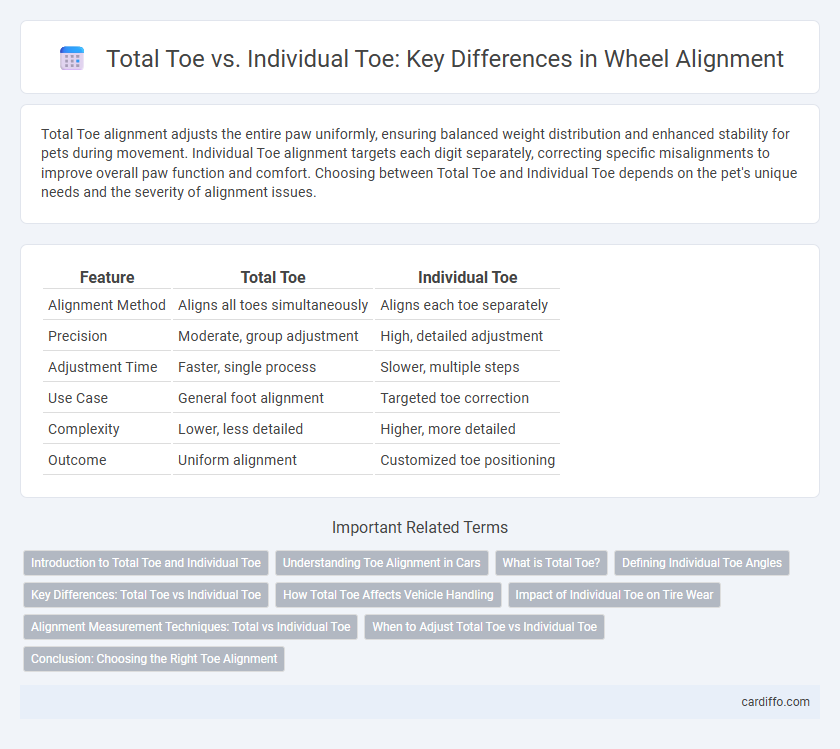Total Toe alignment adjusts the entire paw uniformly, ensuring balanced weight distribution and enhanced stability for pets during movement. Individual Toe alignment targets each digit separately, correcting specific misalignments to improve overall paw function and comfort. Choosing between Total Toe and Individual Toe depends on the pet's unique needs and the severity of alignment issues.
Table of Comparison
| Feature | Total Toe | Individual Toe |
|---|---|---|
| Alignment Method | Aligns all toes simultaneously | Aligns each toe separately |
| Precision | Moderate, group adjustment | High, detailed adjustment |
| Adjustment Time | Faster, single process | Slower, multiple steps |
| Use Case | General foot alignment | Targeted toe correction |
| Complexity | Lower, less detailed | Higher, more detailed |
| Outcome | Uniform alignment | Customized toe positioning |
Introduction to Total Toe and Individual Toe
Total Toe refers to the overall angular measurement of the front wheels relative to the vehicle's centerline, impacting handling stability and tire wear. Individual Toe specifies the toe angle of each wheel independently, allowing precise adjustments to correct alignment discrepancies. Understanding the distinction between Total Toe and Individual Toe is essential for optimizing vehicle steering response and ensuring even tire wear.
Understanding Toe Alignment in Cars
Understanding toe alignment in cars involves distinguishing between total toe and individual toe measurements to ensure precise wheel positioning. Total toe refers to the combined angle of both wheels on an axle, indicating whether they point inward (toe-in) or outward (toe-out), while individual toe measures the angle of each wheel relative to the vehicle's centerline. Accurate toe alignment enhances tire wear, steering response, and overall vehicle stability.
What is Total Toe?
Total Toe refers to the combined angle formed by the inward or outward positioning of both front wheels of a vehicle relative to its longitudinal axis. It is the sum of the individual toe angles of the left and right wheels, measured in degrees or millimeters, indicating how the tires are aligned for optimal handling and tire wear. Proper Total Toe alignment ensures balanced steering response and maximizes tire life by preventing uneven tire wear caused by misalignment.
Defining Individual Toe Angles
Defining individual toe angles involves measuring the orientation of each toe relative to the foot's longitudinal axis, providing detailed insight into toe alignment discrepancies. Total toe angle represents the combined angular deviation of all toes, while individual toe angles isolate the position of each toe for targeted assessment. Accurate measurement of individual toe angles is essential for diagnosing specific biomechanical issues and customizing corrective orthotic interventions.
Key Differences: Total Toe vs Individual Toe
Total toe measures the overall angle of both feet combined, reflecting the collective toe-out or toe-in positioning during gait, while individual toe evaluates each foot separately to identify asymmetries or specific biomechanical deviations. Total toe is useful for assessing general alignment and symmetry in walking patterns, whereas individual toe provides detailed insights into localized abnormalities or compensations in either the left or right foot. Understanding these key differences enhances diagnostic accuracy and informs targeted interventions for improving foot alignment and overall biomechanics.
How Total Toe Affects Vehicle Handling
Total toe significantly influences vehicle handling by altering the overall directional stability and responsiveness. Excessive total toe-in enhances straight-line stability but reduces cornering agility, while total toe-out improves turn-in response at the expense of straight-line control. Precise total toe adjustment balances tire wear and vehicle dynamics, optimizing traction and steering feedback.
Impact of Individual Toe on Tire Wear
Individual toe adjustment directly influences tire wear by altering each wheel's angle relative to the vehicle's centerline, leading to uneven tread wear when improperly set. Excessive individual toe causes increased friction on specific tire edges, accelerating wear patterns and reducing tire lifespan. Proper calibration of individual toe alignment enhances tread uniformity and improves overall tire performance.
Alignment Measurement Techniques: Total vs Individual Toe
Alignment measurement techniques differentiate between total toe, which quantifies the combined angle of both front tires relative to the vehicle's centerline, and individual toe, which measures the angle of each tire independently. Total toe is crucial for assessing overall steering response and vehicle stability, while individual toe adjustments help correct imbalances between left and right tires for precise handling. Accurate alignment relies on tools like laser sensors or optical measuring systems to capture these angles, ensuring optimal tire performance and even tread wear.
When to Adjust Total Toe vs Individual Toe
Adjust total toe alignment when the vehicle exhibits overall directional instability, such as pulling to one side or uneven tire wear affecting both tires on an axle. Individual toe adjustments are necessary when one tire shows abnormal wear patterns or handling irregularities, indicating misalignment specific to that wheel. Properly distinguishing when to adjust total toe versus individual toe ensures optimal tire performance and prolongs tire life.
Conclusion: Choosing the Right Toe Alignment
Total toe alignment offers a comprehensive correction by adjusting all tires simultaneously, enhancing overall vehicle stability and tire wear. Individual toe adjustment targets specific wheels, ideal for fine-tuning and addressing uneven tire wear or handling issues. Selecting the appropriate toe alignment depends on the vehicle's condition, usage patterns, and alignment goals, with total toe adjustments favored for balanced performance and individual toe for precision corrections.
Total Toe vs Individual Toe Infographic

 cardiffo.com
cardiffo.com